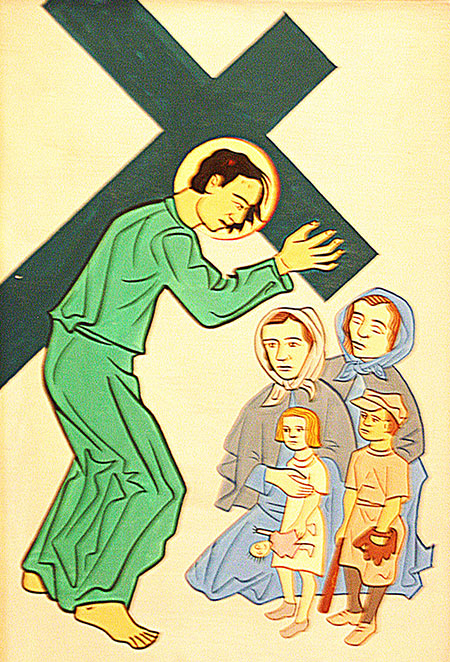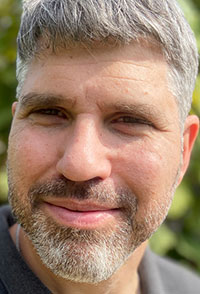
This painting by Father Edward Catich is located in the St. Vincent Center in Davenport.
By Dan Russo
Editor

On either side of the main entrance to the St. Vincent Center, the building that houses both The Catholic Messenger offices and the headquarters of the Diocese of Davenport, there are statues of angels. The pair on guard duty at the door are worn, but sturdy. Stone hands come together under the angels’ chins, pointed up to heaven in prayer. They’ve got wings spread, just like a thousand other angel statutes you might see in somebody’s back yard or in the garden section of a hardware store. It’s not high art. In fact, it’s low art — low to the ground that is — but it got my attention. These simple statues were the first thing I noticed when walking in to visit The Messenger for the first time over a month ago.
This week’s issue of The Catholic Messenger will officially be dated Oct. 2, the feast day of the Guardian Angels. The word angel comes from an ancient Greek word “angelos,” meaning messenger. For these reasons, I want to acknowledge the “persons” of angels in my first “Persons, places and things” column. We don’t usually see them, but our faith tells us they’re doing good things for God and helping us every day, especially when we ask them to.
Angels must have been at work last week when long time editor Barb Arland-Fye said goodbye after more than 20 years with this publication. That was not easy, but she got through it. She’s agreed to continue contributing some editorials and other writing so you’ll still see her work in these pages from time to time as she’s able.
I bring up angels this week for another reason. They remind us of the invisible spiritual reality that co-exists with the material world that’s easy to see. Catholics believe that at Mass, these two worlds come together in a spectacular way when the bread and wine are consecrated.
I was able to go to my first Mass in the diocese at the St. Vincent Center chapel last week. There I saw Father Egidius Kataruga, a priest from Tanzania studying at St. Ambrose University, celebrate daily Mass with a group of retired Davenport priests who live at the center with him. Father Kataruga is young and, comparatively speaking, just starting his ministry. The retired residents, in contrast, have already spent most of their lives working for the Church. At this daily Mass, different generations and cultures were united by Jesus in the Eucharist in a very intimate setting. It’s rare as a lay person to be able to attend Mass with fewer than a dozen people, but on that day, I could. It was ordinary and amazing at the same time.
As I walked out of the chapel, I noticed unusual images on the wall. Instead of a typical Stations of the Cross display depicting Roman soldiers and civilians dressed like they would have been over 2,000 years ago, there were people in 20th century style clothes crowding around Jesus. In one painting, a little girl holding a doll and a boy with an American baseball glove and bat are watching as Jesus goes by with the cross. I later learned that Father Edward Catich had created the art. I had never heard of this internationally famous priest-artist who founded the St. Ambrose University art department. He is known for calligraphy and did the main lettering on The Messenger front page that is still used today. His work caused controversy in its time for depicting sacred themes in unconventional ways. I wondered why he would show modern children as witnesses of the crucifixion.
I don’t know for sure what the artist was getting at, but, for me, the jarring contrast of the kids’ innocence with a bloody execution made me stop and think about Jesus’ sacrifice in a way I otherwise wouldn’t have. We are all pure as children after our baptism. At some point, life gets messy. We get dirty and hurt, like a baseball player after nine innings. In the end, however, Jesus promises he can make us innocent again, like small children, if we follow him.
Both pieces of art I saw — the “low art” angel statue and Catich’s “high art” — helped me get in touch with unseen realities that have an impact on the physical world. Catholicism teaches us that the gift of faith can help us see that the spiritual world is just as real as stone or paint. I’m glad I was reminded of that through art and angels during my first days at The Messenger. Please pray that the staff here get a few extra angels sent to us as the adventure continues.
I want to thank Bishop Dennis Walsh, pastors, parishioners, religious communities and parish staff across the diocese for supporting local Catholic journalism. I appreciate the opportunity I’ve been given and will be working over the next several months to learn about The Messenger and the Diocese of Davenport. If you have any suggestions or feedback for me, please let me know.
(Dan Russo can be contacted at russo@davenportdiocese.org.)








